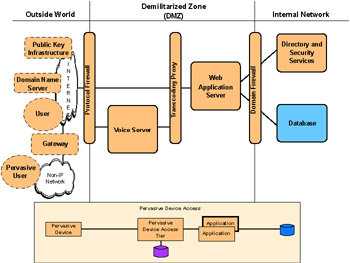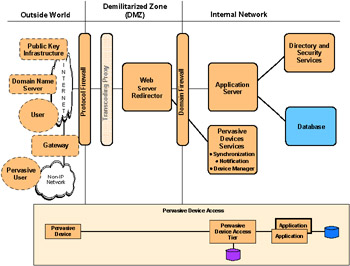4.3 Runtime pattern for the Pervasive Device Access application
4.3 Runtime pattern for the Pervasive Device Access application
Self-Service runtime patterns provide the foundation for the Pervasive Device Access Runtime pattern in this book. The Access Integration::Pervasive Device Access application pattern provides the support for pervasive solutions.
In the last Runtime pattern, we extend the Portal composite pattern with the Pervasive Device Access pattern to provide a so called "Pervasive Portal" type of solution, where all the Access Integration functions come together in one place.
4.3.1 Access Integration pattern
The Access Integration pattern provides users with a seamless and consistent user experience that combines access to multiple applications, databases, services and presentation through multiple devices.
There are multiple runtime patterns defined for this integration pattern and you can see each of them in detail by referring to the Patterns for e-Business site at:
-
http://www-106.ibm.com/developerworks/patterns/
Old Pervasive Device Access Runtime pattern
The following Runtime pattern is from the redbook Mobile Applications with IBM WebSphere Everyplace Access - Design and Development , SG24-6259. It was based on the technologies available in WebSphere Everyplace Access V1.1. This Runtime pattern serves as a quick introduction to see where the pervasive technologies started in the WebSphere Everyplace Access product line.

Figure 4-3: Old Pervasive Device Access Runtime pattern
The main technology that drove the solution was transcoding. The transcoding proxy took care of the requests and responses from and to the different pervasive devices. The transcoding proxy had three runtime modes:
-
Reverse-proxy
-
Forward-proxy
-
Servlet filter for WebSphere
The voice server provided voice recognition and voice synthesis for the solution; enabling the applications for clients using traditional phone to access the application.
The Web application was a classic J2EE application with minor modifications to support pervasive device access.
Pervasive Device Access Runtime pattern: Variation 1
This Runtime pattern extends the Self-Service Basic Variation 1 Runtime pattern to allow a wide variety of pervasive devices to participate in the e-business solution.
There are two Pervasive Access runtime patterns defined on the Patterns for e-Business site at:
-
http://www-106.ibm.com/developerworks/patterns/
The Pervasive Device Access runtime pattern Variation 1 is a variation to these two Runtime patterns.
This pattern assumes that there are incoming requests for the application from both IP and non-IP networks. The non-IP network consists of wireless networks (GSM, CDPD, etc.) and phone networks (PTSN). In order to access the IP-based networks (Internet or intranet), a special gateway is required. Phone networks require Voice over IP gateways to connect the analog or digital lines connection to the IP-based, packet-switched networks. Wireless networks also have to use gateways to handle the connections, translate the protocols, and connect to IP networks (for example WAP or i-mode).
The functionalities that are part of a pervasive solution and are included in this Runtime pattern are:
-
Connectivity - it is implemented by the Gateway node providing communication between pervasive devices and the Web applications.
-
Application server - in this scenario, the application server hosts the application that is designed to handle different type of devices. It is more like a programmatic approach and it is most common for well designed existing Web applications with minor modifications or applications that only need to support a few (one or two) different device presentation logics.
-
Notification - provides message interchange between users and applications.
-
Synchronization - provides data synchronization with several applications like mail servers and relational databases through several communication channels.
-
Device Management - provides identification, configuration, inventory management and software distribution to devices such as personal digital assistants (PDAs), handheld PCs, smartphones, wireless access protocol (WAP) devices, or other emerging devices for pervasive computing.

Figure 4-4: Pervasive Device Access Runtime pattern ” Variation 1
This Runtime pattern is based on the n- tier model and supports browser users (client node) and mobile users (pervasive user node) accessing back-end applications. The mobile users will have to pass through the gateway to access the IP network and through the transcoding proxy to adapt the content, based on the type and capabilities of the mobile user device.
The presentation tier is split into two, represented by the Web Server Redirector and the Application Server nodes. In this case, the application server has to take care of the presentation for the different devices. It can be done programmatically, or using the WebSphere Transcoding Publisher product as an intermediary node. For more information about the WebSphere Transcoding Publisher solution, refer to the redbook Mobile Applications with IBM WebSphere Everyplace Access - Design and Development , SG24-6259.
The Self-Service application runs on the application server. The notification, synchronization and device manager services also run in the application tier on a separate node.
The relevant data that should be stored in the database for each component is as follows :
-
For the notification - privacy policies, context data and subscriptions.
-
For the synchronization - configuration information, enterprise database access information, user IDs and passwords, user device preferences and data replicas. In order to improve performance and security in the synchronization process, the synchronization node can implement a cache by replicating the data from the back-end database.
-
For the device manager - device management information.
The authentication information and user profiles will be held by the directory and security node and is protected by the domain firewall in the internal network.
EAN: 2147483647
Pages: 83